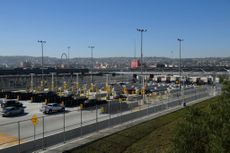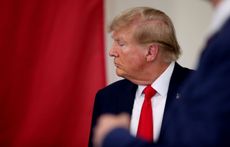Why the left must start thinking hard about the Green New Deal
There's no time to lose


The rollout of the Green New Deal has hit a few snags. First there was an odd FAQ document that was widely attacked, then mysteriously withdrawn, creating a lot of confusion. Sen. Sherrod Brown (D-Ohio.), a working-class champion, has so far declined to endorse the official resolution.
Still, at bottom it's fairly clear what the Green New Deal is: an aspirational climate policy wish list. As far as setting goals, it's at least in the right ball park. But it's time now to start building out specific policies that will actually get where we need to go.
The political strategy behind the Green New Deal resolution goes something like this: It sets goals roughly commensurate with what the United States must do to fulfill its climate obligations (namely, cut its emissions by 50 percent by 2030) and commits to building out the details moving forward. As David Roberts writes at Vox, "It has to offer enough specifics to give it real shape and ambition, without overprescribing solutions or prejudging differences over secondary questions. It has to please a diverse range of interest groups, from environmental justice to labor to climate, without alienating any of them."
Subscribe to The Week
Escape your echo chamber. Get the facts behind the news, plus analysis from multiple perspectives.

Sign up for The Week's Free Newsletters
From our morning news briefing to a weekly Good News Newsletter, get the best of The Week delivered directly to your inbox.
From our morning news briefing to a weekly Good News Newsletter, get the best of The Week delivered directly to your inbox.
That's a fair set of priorities at this point. Indeed, it's similar to where Medicare-for-all was around 2016: short on details, but with a clear destination in mind. (Steadily more workable proposals have since been put forward.)
However, there is an important difference between these two positions. In the case of Medicare-for-all, there are numerous other countries with functioning single-payer systems that serve as a proof of concept. It's not so important to get the details filled out years before any bill could even be written if we know for a fact that the policy can work.
But there is no such example for the Green New Deal. So even though Democrats are at least two years away from being able to actually pass legislation into law, it's still important for the broad left to start thinking hard about details. Most parts of the climate coalition are going to have to swallow some uncomfortable policies, so it's important to start convincing people now that it's necessary.
Ramez Naam has a very lucid breakdown of the state of zero-carbon technology that illustrates the problem. In some areas, the climate policy logic is obvious: On electrical power generation, we are more or less where we need to be. Renewables are nearly cost competitive with carbon power, thanks to decades of subsidies and industrial planning from Germany, China, and the U.S (to a lesser extent). What is needed is a breakneck deployment of existing technology, adapted and improved where possible.
Still, even that will mean some tough choices for Green New Deal supporters. Given the scale of the climate crisis, it would be senseless to leave aside hydro and nuclear, which could also provide many hundreds of green terawatt-hours per year. At least existing nuclear (a fifth of current U.S. power generation) must be preserved while coal and natural gas are being dismantled.
Transportation is more of a mixed bag. Electric cars and (especially) buses are making strong strides. The U.S. passenger rail system is a pitiful joke that doesn't serve most of the country, and where it does, speeds are worse than a century ago — which makes it an obvious candidate for Green New Deal investment. A proper high-speed rail network could provide fast, zero-carbon (once the power grid is de-carbonized) transportation service that could partly replace air travel.
Still, U.S. infrastructure prices are outrageously high, and its train management is abysmal by European standards. Any major train program will need to address these problems — and whatever combination of corruption, incompetence, and ignorance is causing them, it is not immediately obvious how to fix them.
What's more, even the fastest trains can't compete with airlines over long distances, nor transport goods across the ocean. De-carbonizing international flights and shipping is going to be difficult, though initial strides are being made with slower speeds, advanced energy storage, and adding sails to big ships. But it may be the case that air travel becomes much more expensive.
Most challenging of all in terms of emissions sources are agriculture, industry, and manufacturing, which make up nearly half of greenhouse gas emissions. Iron smelting, concrete production, livestock farming especially produce gobs of emissions, and there is no immediately workable policy on hand at all to de-carbonize those things. The projected huge growth in meat consumption alone would be a disaster for the climate.
Finally, there is the fact that the U.S. only produces about 15 percent of global emissions. A Green New Deal cannot be focused only on America; it must help and/or push other countries into cutting their emissions as well.
As Naam argues, these last two realities imply any U.S. climate bill should include a huge research budget to try to develop zero-carbon steel, concrete, and agriculture, as well as carbon capture, with the idea of accelerating those technologies worldwide, just like Germany accelerated solar panels in years past. I would add that there is an important diplomatic logic to smashing down domestic emissions, because it would make it easier for other countries to pursue their own emissions cuts. It is strongly in the interest of China and India to cut their emissions, because both are very vulnerable to climate change, and either one alone could cause sufficiently bad climate change to wreck their own countries. But when the U.S., the world's second-largest emitter whose emission cuts would be comparatively easy, is twiddling its thumbs, it's easy to conclude it's pointless to try very hard.
At any rate, if a Green New Deal follows the foundational logic of its namesake, it will be a great big Keynesian infrastructure investment to slash greenhouse gas emissions and reconfigure the economy in a more egalitarian direction. The specific outlines of what that should look like are coming into view, but a great deal more work will have to be done to fill it out. It's time to get to work.
Create an account with the same email registered to your subscription to unlock access.
Sign up for Today's Best Articles in your inbox
A free daily email with the biggest news stories of the day – and the best features from TheWeek.com
Ryan Cooper is a national correspondent at TheWeek.com. His work has appeared in the Washington Monthly, The New Republic, and the Washington Post.
-
 'Make legal immigration a more plausible option'
'Make legal immigration a more plausible option'Instant Opinion Opinion, comment and editorials of the day
By Harold Maass, The Week US Published
-
 LA-to-Las Vegas high-speed rail line breaks ground
LA-to-Las Vegas high-speed rail line breaks groundSpeed Read The railway will be ready as soon as 2028
By Peter Weber, The Week US Published
-
 Israel's military intelligence chief resigns
Israel's military intelligence chief resignsSpeed Read Maj. Gen. Aharon Haliva is the first leader to quit for failing to prevent the Hamas attack in October
By Justin Klawans, The Week US Published
-
 Arizona court reinstates 1864 abortion ban
Arizona court reinstates 1864 abortion banSpeed Read The law makes all abortions illegal in the state except to save the mother's life
By Rafi Schwartz, The Week US Published
-
 Trump, billions richer, is selling Bibles
Trump, billions richer, is selling BiblesSpeed Read The former president is hawking a $60 "God Bless the USA Bible"
By Peter Weber, The Week US Published
-
 The debate about Biden's age and mental fitness
The debate about Biden's age and mental fitnessIn Depth Some critics argue Biden is too old to run again. Does the argument have merit?
By Grayson Quay Published
-
 How would a second Trump presidency affect Britain?
How would a second Trump presidency affect Britain?Today's Big Question Re-election of Republican frontrunner could threaten UK security, warns former head of secret service
By Harriet Marsden, The Week UK Published
-
 'Rwanda plan is less a deterrent and more a bluff'
'Rwanda plan is less a deterrent and more a bluff'Instant Opinion Opinion, comment and editorials of the day
By The Week UK Published
-
 Henry Kissinger dies aged 100: a complicated legacy?
Henry Kissinger dies aged 100: a complicated legacy?Talking Point Top US diplomat and Nobel Peace Prize winner remembered as both foreign policy genius and war criminal
By Harriet Marsden, The Week UK Last updated
-
 Trump’s rhetoric: a shift to 'straight-up Nazi talk'
Trump’s rhetoric: a shift to 'straight-up Nazi talk'Why everyone's talking about Would-be president's sinister language is backed by an incendiary policy agenda, say commentators
By The Week UK Published
-
 More covfefe: is the world ready for a second Donald Trump presidency?
More covfefe: is the world ready for a second Donald Trump presidency?Today's Big Question Republican's re-election would be a 'nightmare' scenario for Europe, Ukraine and the West
By Sorcha Bradley, The Week UK Published